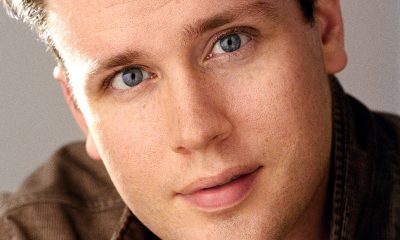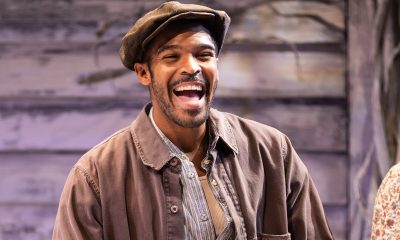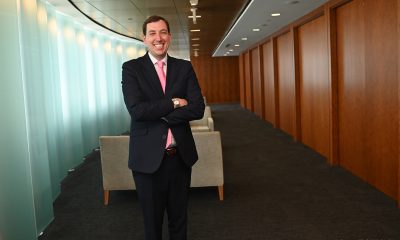Sports
Meet 2 couples sharing their lives and a love of sports
Rowing, swimming offer friendly competition and a common bond
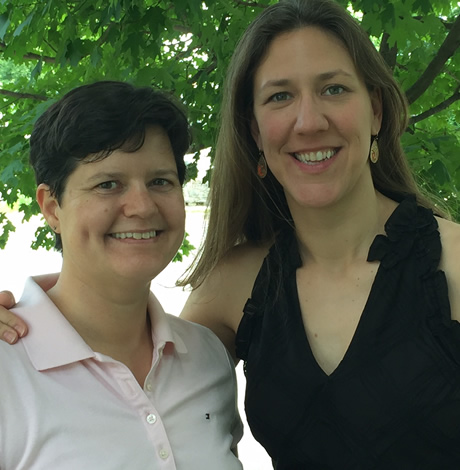
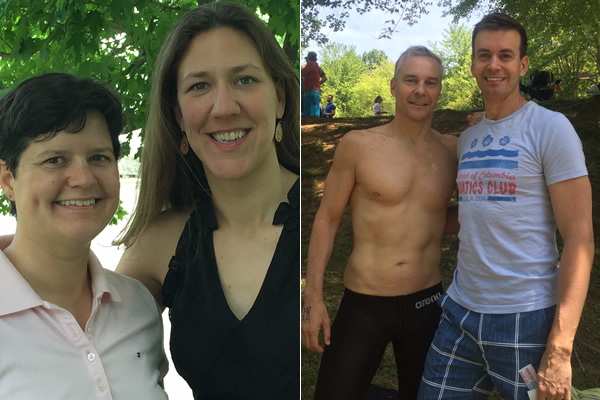
On left, Sheila and Gretchen O’Sullivan are members of the DC Strokes Rowing Club. On right, Fred Dever and Eric Czander met on the DC Aquatics team. (Photos courtesy of the couples)
Many of the LGBT sports teams in D.C. count same-sex couples as members of their clubs. Some joined the team together and others became a couple after first being teammates.
Meet two LGBT couples who have woven sports into the lives they are sharing. Not only are they benefitting their own health and well-being, they are sharing it with their partner.
Sheila O’Sullivan grew up in Novi, Mich., where soccer was her sport of choice. She attended high school in England and added rowing as her spring sport.
Back in the States, she graduated from the Coast Guard Academy in Connecticut in 2000. She coached rowing on Sammamish Lake in Washington before heading to grad school at Carnegie Mellon University.
Canonsburg, Pa. was home to Gretchen O’Sullivan where she played softball and tennis in high school. She attended Allegheny College and was a member of the orchestra. A stint with AmeriCorps was followed by grad school at Carnegie Mellon.
The pair became a couple after meeting at grad school in Pittsburgh. Sheila would graduate first in 2007 and leave to work with the Peace Corps before moving to D.C. in 2009 where she joined the club program of the DC Strokes Rowing Club.
“After she left I joined the learn to row program with Three Rivers Rowing in Pittsburgh,” says Gretchen. “It was all because of Sheila. I never would have thought of rowing otherwise.”
Gretchen came to D.C. the following year and started with the DC Strokes novice program. She eventually joined Sheila in the club program and they often ended up in the same boat.
“She would get frustrated with me, but the overall experience was great,” says Sheila. “It’s great being outside and working as a team. We met our core group of friends with the Strokes and even if we are not rowing, they remain in our lives.”
“She was only trying to help me when we were in a boat together, but it was sometimes stressful,” Gretchen says. “Otherwise it was wonderful and there was great energy. Our drives back and forth to practice were always fun.”
Life started getting in the way for the pair and they began swapping rowing seasons to be supportive of who had the time to row. There was work, a new puppy, a new house, and they got married in the spring of 2013.
Both were competing in regattas – Sheila moved up to the competitive program and rowed at Stonewall, Charm City Sprints and the Head of the Hooch in Tennessee; Gretchen at the 2014 Gay Games in Cleveland where she won medals of each color.
Gretchen was trying to get pregnant in 2015 which meant that it was Sheila’s turn to row again. Their baby was born in late 2016 and Sheila started training for a new job with the Park Police. Gretchen is working as a site coordinator with a national nonprofit. Both are currently not rowing but are itching to get back in the boat.
“I really wanted to stay involved, so I am serving on the DC Strokes board as secretary,” says Gretchen. “Rowing is really for everyone and you can adapt it to your own needs. I would love for her to row again and I also see it for myself on the horizon.”
“I love that it is something you can come back to at any age and I am inspired by rowers that are older,” Sheila says. “Rowing is a passion of mine and it will be a lifetime sport for me.”
Syracuse, N.Y. native Fred Dever grew up competing in swimming and water polo through high school. He was an NCAA Division I swimmer at Marist College for four years and captained in his final year. On the side, he lifeguarded and coached swimming and water polo.
His work in pharmaceutical sales brought him to D.C. in 1995 and he was reluctant to join DC Aquatics Club because he didn’t think a gay team would be serious.
“I joined the team in 2002 and it was great getting back into organized workouts and making new friends,” says Fred. “It’s super rewarding, competitive, and everything you can wish for as a gay athlete.”
Eric Czander started swimming year around at age nine while growing up in Westfield, N.J. He swam for four years as an NCAA Division I athlete at Vanderbilt University. His education continued at Rutgers New Jersey Medical School and Emory University School of Medicine for his Neurology residency.
He signed on for five years in the Navy hoping that the military lifestyle would prevent him from coming out. Before his duty began, he joined masters swimming and helped form a gay team in Atlanta where he came out in 1993. His last two years in the military brought him to D.C. where he joined DC Aquatics in 1998.
Fred and Eric met on the team and have spent the last 16 years sharing their lives with a healthy dose of swimming, triathlons and running.
“It helps with motivation to have someone to go to practice with and just having someone by your side,” says Eric. “It’s nice to be able to bounce things off each other. We are each other’s biggest motivator and biggest critic.”
“I like the way it feels having sports in our lives,” Fred says. “I would be a slacker if it wasn’t for Eric. He is much more driven than I am.”
Fred and Eric are the same age and compete in the same age group in swimming, though not in the same events. They are also of the same ability and purposefully don’t train in the same lane at practice.
“There is a little competitiveness in practice even though we don’t swim the same events,” Eric says. “Never harmful though, always healthy. Both of us have grown and learned from each other.”
“Sometimes I just want my own space, so I can be silly with our other teammates,” adds Fred.
In addition to competitive swimming, Fred and Eric have also completed running marathons and triathlons together. Eric had been competing in them for years before meeting Fred and brought him into the sports.
“My first marathon in D.C. was cancelled and Eric pushed me to run the St. Louis Marathon,” says Fred. “We always make sure the other one is safe in our races. Someone died in a recent open water race we were in and I ended up in the medical tent at the Boston Marathon. Each race starts with “I love you, be safe.”’
“When he started doing road running and triathlons, I was beating him at first and then he started beating me,” says Eric. “We try not to race next to each other, but our times are very similar. It’s good motivation.”
Coming up for the pair is a trip to Paris for Gay Games X in August where they both will be swimming eight events in the pool.
“Swimming is all about family and connections,” Fred says. “Our DC Aquatics teammates are our family.”
“It’s awesome to explore new cities and cultures together,” Eric says. “Plus, I can’t wait for Fred to butcher the French language.”
Sports
Brittney Griner, wife expecting first child
WNBA star released from Russian gulag in December 2022
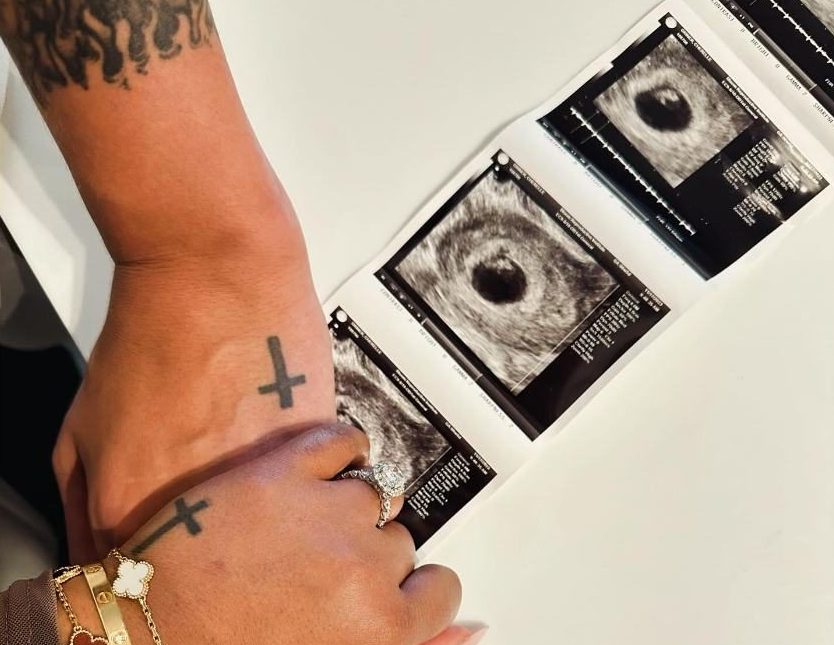
One year after returning to the WNBA after her release from a Russian gulag and declaring, “I’m never playing overseas again,” Phoenix Mercury star Brittney Griner and her wife announced they have something even bigger coming up this summer.
Cherelle, 31, and Brittney, 33, are expecting their first child in July. The couple shared the news with their 715,000 followers on Instagram.
“Can’t believe we’re less than three months away from meeting our favorite human being,” the caption read, with the hashtag, #BabyGrinerComingSoon and #July2024.
Griner returned to the U.S. in December 2022 in a prisoner swap, more than nine months after being arrested in Moscow for possession of vape cartridges containing prescription cannabis.
In April 2023, at her first news conference following her release, the two-time Olympic gold medalist made only one exception to her vow to never play overseas again: To return to the Summer Olympic Games, which will be played in Paris starting in July, the same month “Baby Griner” is due. “The only time I would want to would be to represent the USA,” she said last year.
Given that the unrestricted free agent is on the roster of both Team USA and her WNBA team, it’s not immediately clear where Griner will be when their first child arrives.
The Griners purchased their “forever home” in Phoenix just last year.
“Phoenix is home,” Griner said at the Mercury’s end-of-season media day, according to ESPN. “Me and my wife literally just got a place. This is it.”
As the Los Angeles Blade reported last December, Griner is working with Good Morning America anchor Robin Roberts — like Griner, a married lesbian — on an ESPN television documentary as well as a television series for ABC about her life story. Cherelle is executive producer of these projects.
Next month, Griner’s tell-all memoir of her Russian incarceration will be published by Penguin Random House. It’s titled “Coming Home” and the hardcover hits bookstores on May 7.
Sports
Applause and criticism for Staley’s trans-inclusive stance
South Carolina Gamecocks women’s coach made comments on Sunday
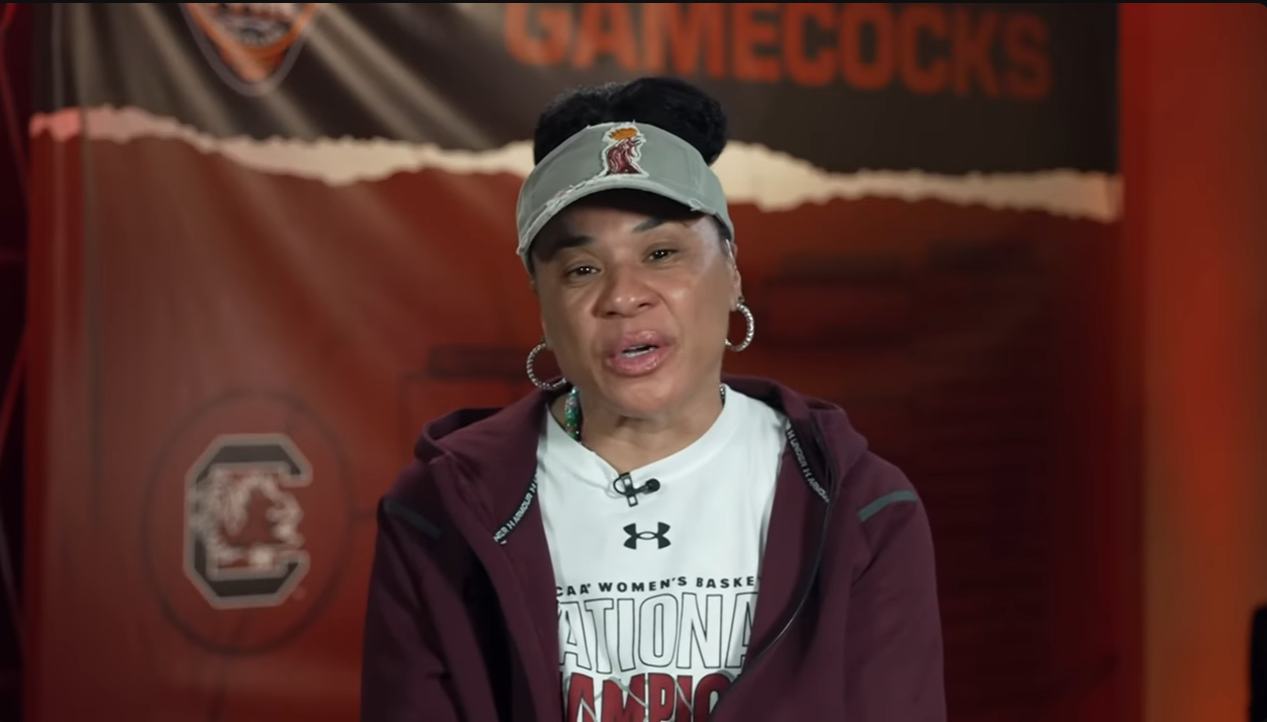
If not for a conservative transphobic blogger, this moment should be a celebration of NCAA women’s basketball coach Dawn Staley and the women of the South Carolina Gamecocks.
On Sunday, they concluded their undefeated season with a decisive win and a championship title. But when Staley faced reporters before that big game, Outkick’s Dan Zakheske asked her an irrelevant, clickbait question about transgender women in sports, referring to them as “biological males.”
Staley could have ignored the question, or stated she had no opinion, but instead the legendary coach offered a crystal clear endorsement of trans women competing in women’s sports, something outlawed in her home state of South Carolina for girls in kindergarten through college.
“I’m of the opinion,” said Staley, “If you’re a woman, you should play. If you consider yourself a woman and you want to play sports or vice versa, you should be able to play. That’s my opinion.”
Zakheske clearly wasn’t satisfied with that declaration of allyship and Staley swiftly cut him off.
“You want me to go deeper?” she asked.
“Do you think transgender women should be able to participate,” he started to say, when the coach stole the ball and took it downtown on a fastbreak. “That’s the question you want to ask? I’ll give you that. Yes. Yes. So, now the barnstormer people are going to flood my timeline and be a distraction to me on one of the biggest days of our game, and I’m okay with that. I really am.”
Staley is herself a Hall of Fame player a leading voice for diversity.
Reaction to her comments were swift, from LGBTQ rights organizations, athletes and inclusion opponents.
“Coach Staley simply spoke the truth that trans women are women and should play if they want,” said Sarah Kate Ellis, president and CEO of GLAAD, in a post on Instagram. “All of us can take a page from Coach Staley’s playbook as a sports leader and as a person of high integrity guided by faith, compassion and common sense.”
A White House pool reporter revealed President Joe Biden called Staley Sunday evening to congratulate her and the Gamecocks on their championship win. But it’s not clear if she and the president, an outspoken supporter of trans rights, discussed her remarks on trans athletes.
A number of Black leaders in the LGBTQ movement applauded Staley for taking a stand.
“Coach Staley has always been a trailblazer, but she’s also shown that true leadership is about advancing justice and equality for everyone,” said Human Rights Campaign President Kelley Robinson. “By expressing her full-throated support for transgender athletes’ inclusion in sports, she’s sending an important message — our shared humanity matters.
“Coach Staley showed courage and vulnerability, in choosing to answer the question and make a powerful statement of support for trans people on one of the biggest days and biggest stages in sports history,” said Kierra Johnson, executive director of the National LGBTQ Task Force, in a statement. “Not only does that make her a leader we can all aspire to like, it makes her a class act. She has etched her legacy in the history books with her play, her coaching, her heart and her smarts.”
In congratulating Staley on her championship title victory, Dr. David J. Johns, the CEO and executive director of the National Black Justice Coalition, also commended her for “her unwavering advocacy and support for transgender people in sports.”
“In a time when transgender athetes face unjust scrutiny, discrimination and exclusion from the National Association of Intercollegiate Athletics, her courage to speak truth to power and in support of inclusion and fairness sets a powerful example for us all, and is a testament to her integrity and compassion.”
The NBJC leader was referring to Monday’s announcement by the NAIA, the governing body of athletic programs at small colleges nationwide, voting 20-0 to essentially ban trans women from competing with other women beginning Aug. 1, as ESPN reported.
“It is a shocking and devastating development that the NAIA, an organization that has done so much to open doors, is now slamming those doors shut on transgender athletes,” said Sasha Buchert, Lambda Legal’s senior attorney and director of the organization’s nonbinary and trans rights project.
“Instead of standing up in support of transgender young people, the NAIA has simply turned its back on them — permanently depriving them of the benefits of competition. Would that they had the courage of victorious University of South Carolina women’s basketball coach Dawn Staley, who didn’t miss a beat in clarifying that transgender women should be able to play.”
However, praise for Staley’s stance was not universal.
Riley Gaines, failed former college swimmer and paid shill for the anti-inclusion organization, Independent Women’s Forum, called Staley “entirely incompetent or a sell-out” on Fox News. “Personally, I don’t think she believes what she said.”
Gaines has turned her fifth-place tie with out trans NCAA champion Lia Thomas into a career as a crusader against inclusion and a former advisor to the presidential campaign of Florida Gov. Ron DeSantis.
Val Whiting, a former Stanford University and professional women’s basketball player, tweeted her strong disagreement with Staley. “A lot of my basketball sisters feel differently but trans women do not belong in women’s sports. It’s not fair nor safe for biological women. There has to be another solution for trans women to be able to compete athletically besides having them compete against biological women.”
A lot of my basketball sisters feel differently but trans women do not belong in women’s sports. It’s not fair nor safe for biological women. There has to be another solution for trans women to be able to compete athletically besides having them compete against biological women.
— Val Whiting (@iamcoachval) April 7, 2024
Zaksheske’s Outkick colleague, anti-trans pundit David Hookstead, also went all-in with a transphobic post.
“Dawn Staley says she supports men who identify as women competing against real women in sports. Her view could literally destroy women’s basketball forever. Why won’t more people stand up for women?”
Dawn Staley says she supports men who identify as women competing against real women in sports.
— David Hookstead (@dhookstead) April 6, 2024
Her view could literally destroy women’s basketball forever.
Why won’t more people stand up for women? pic.twitter.com/2A59KTqvHb
Hookstead then boasted that Staley blocked his account.
Republican South Carolina Congresswoman Nancy Mace retweeted Zaksheske’s account of his interaction with Staley, calling her support of trans athletes “absolute lunacy.” That in turn won praise from Caitlyn Jenner, who retweeted Whiting and posted her thanks to Mace, along with this comment: “There is nothing complicated about this issue!”
What is complicated is that Jenner has never explained why she has competed with cisgender women in golf ever since her transition almost a decade ago.
You’re a hypocrite. pic.twitter.com/42DKwA9jmF
— Art Candee 🍿🥤 (@ArtCandee) April 7, 2024
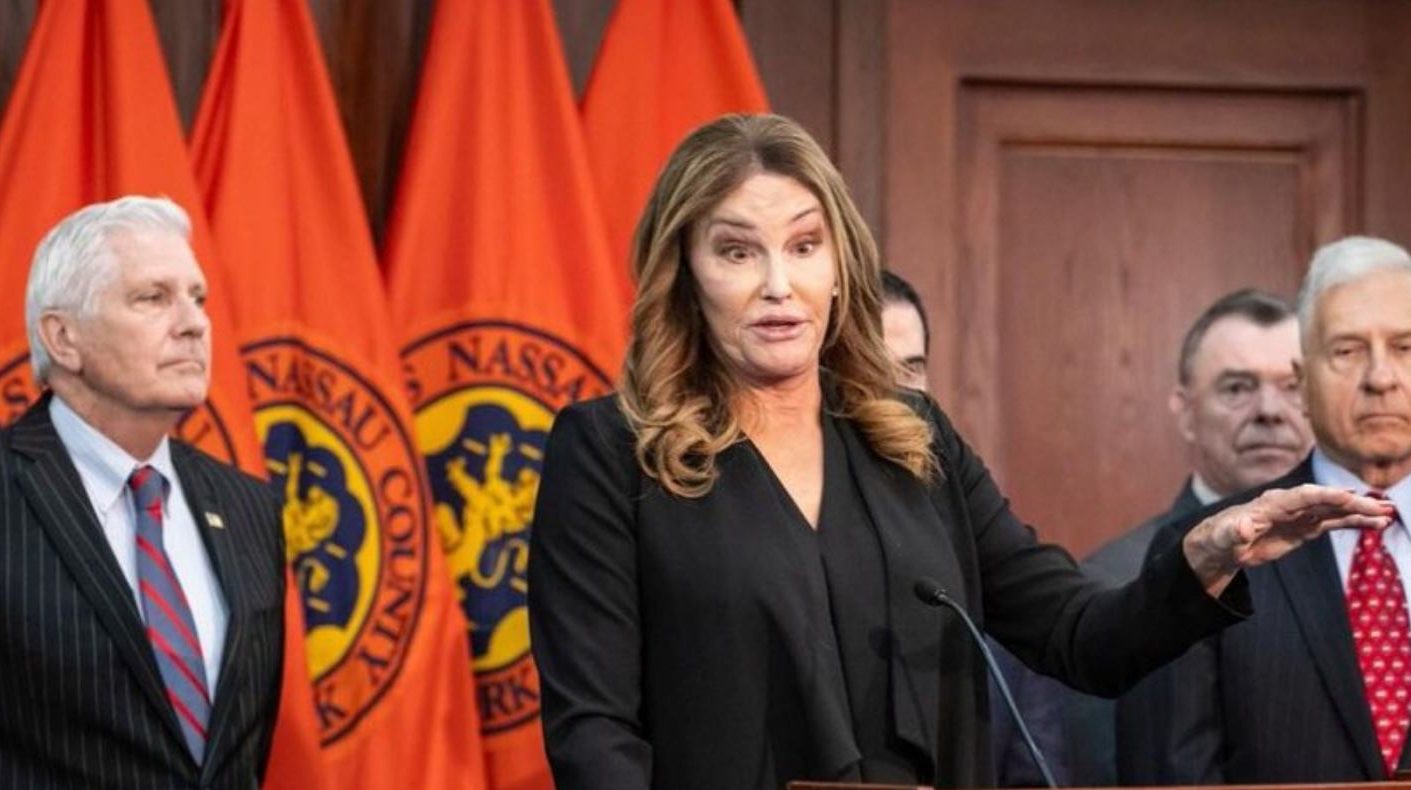
Caitlyn Jenner flew from Malibu to New York this week to join her fellow Republicans in their nationwide quest to keep transgender girls and women from competing in sports with other women.
“Let’s stop it now while we can,” said the Olympic gold medalist, at a news conference carried live by Fox News Channel.
Republican Nassau County Executive Bruce Blakeman organized the event so that Jenner could speak in support of his February executive order banning trans athletes at more than 100 county-owned facilities.
“Trans women are competing against women, taking valuable opportunities for the long-protected class under Title IX and causing physical harm,” said Jenner without providing supportive evidence of her claim. Jenner said the ban would defeat “the woke agenda.”
Her comments drew praise from former NCAA swimmer and paid shill Riley Gaines, who represents the Independent Women’s Forum and has also worked with the failed presidential campaign of Republican Gov. Ron DeSantis of Florida on his anti-trans athlete platform.
We stand with Executive Blakeman as he faces shameful retaliation from @TishJames for merely protecting sports on the basis of sex
— Riley Gaines (@Riley_Gaines_) March 18, 2024
Thanks to you both, @Caitlyn_Jenner @NassauExec !!👏🏼 https://t.co/vAsWfayI7l
“If the left wants to fight this battle on this hill, it’s a losing battle,” said Jenner. “We will win the battle.” She claimed she spoke on behalf of women and girls, contradicting her past statements in support of trans girls competing according to their gender identity and despite the fact she herself still competes in women’s sports.
Shortly after the ban was announced last month, New York State Attorney General Letitia James and New York Gov. Kathy Hochul, both Democrats, denounced it and accused Blakeman of “bullying trans kids.”
James called the order “transphobic and deeply dangerous,” and argued that it violates the state’s anti-discrimination laws. The state attorney general challenged it in court March 1 with a “cease and desist letter,” demanding that Blakeman rescind the order, saying it subjects women’s and girls’ sports teams to “invasive questioning.”
As the Los Angeles Blade reported, Blakeman’s legal team countered with its own lawsuit on March 5, claiming her cease and desist letter violates the 14th Amendment’s equal protection clause.
“Not only was the executive order legal, but we had an obligation to defend it,” Blakeman said Monday.
The order has also been challenged by the New York Civil Liberties Union, which filed suit last week on behalf of a women’s roller derby league based in Nassau County that welcomes trans women and would be barred from using the county’s facilities by Blakeman’s executive order.
Just days before the Long Island news conference, Jenner joined Olympian Sharron Davies, who also campaigns against trans inclusion in sports, for an conversation with a British newspaper, the Telegraph, which has been outspoken against trans inclusion.
They recalled that in their day, tests to determine sex were mandatory in order to compete, and Jenner said she has been “pushing” for sex tests to return to sports, decades after sports organizations around the world abandoned the practice because they were unreliable. “If they continue down this road, it will be pretty much the end of women’s sport as we know it.”
“I can still hit a golf ball 280 yards,” Jenner continued, not mentioning she plays from the ladies’ tee. She did however opine about not being “a real woman,” acknowledging that many trans women disagree with her view.
“They keep saying, ‘Oh, I’m a real woman, I’m a real woman,’ and I’m going, ‘No, you’re not,’” said Jenner. “I will use your preferred pronouns, I will treat you as a female, you can run and dress and do whatever you want, I have nothing against that, it’s fine, but biologically you’re still male.”
She added: “Let me explain — I am biologically male, OK? I’m XY. There’s nothing I can do to change that. If you believe in gender dysphoria, and I think most people do realize it’s not a disease, it’s a mental condition, just like some people are left-handed and some people are right-handed, it’s kind of the way you’re born and I’ve dealt with it my entire life.“
“I consider myself a trans person, I am still genetically male, I changed all of my ID right down to my birth certificate so technically yes, I am female, but on the other hand I know I’m not.”
Related:
-

 State Department2 days ago
State Department2 days agoState Department releases annual human rights report
-
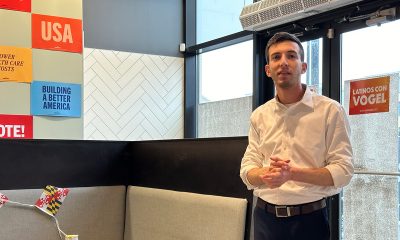
 Maryland4 days ago
Maryland4 days agoJoe Vogel campaign holds ‘Big Gay Canvass Kickoff’
-

 Politics3 days ago
Politics3 days agoSmithsonian staff concerned about future of LGBTQ programming amid GOP scrutiny
-

 The White House1 day ago
The White House1 day agoWhite House debuts action plan targeting pollutants in drinking water

